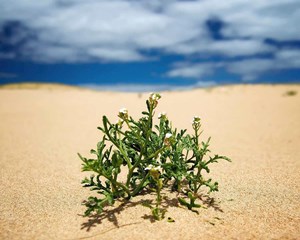First, having established them as seedlings, they starved their charges of phosphorus until signs of deficiency such as yellow leaves appeared. Then they scattered desert dust on the leaves of half of the specimens of each species, while taking steps to stop any of it reaching the soil. After this, though the dust-dosed maize continued to suffer from phosphorus deficiency, the wheat and chickpea plants perked up and grew to more than double the size of their undusted lab-mates. What is more, these species were clearly ready for the dust's arrival. As soon as a lack of phosphorus announced itself, two things happened. Their leaves became hairier, and therefore better at capturing dust. And those leaves also started secreting acid fluids that could dissolve any incoming apatite, assisting phosphorus's absorption.
首先,在培育出幼苗后,它们开始缺乏磷,直到出现黄叶等缺磷迹象。然后,他们把沙漠灰尘撒在每个物种一半标本的叶子上,同时采取措施阻止灰尘进入土壤。在这之后,尽管施了灰尘的玉米持续遭受缺磷的折磨,小麦和鹰嘴豆植株却活跃起来,长得比未施灰尘的同类植株大了两倍多。更重要的是,这些物种显然已经为尘埃的到来做好了准备。缺磷现象一旦发生,就会出现两种情况。它们的叶子变得多毛,因此捕捉灰尘的能力更强。这些叶子也开始分泌酸性液体,可以溶解任何进入的磷灰石,帮助磷的吸收。

That plants can take up phosphorus through their leaves is not, of itself, news to farmers—for this was established in the 1950s. But until now the practical consequence of such knowledge has been that crops are sprayed with liquid fertiliser derived, in turn, from apatite-containing rocks which have been treated with acid. Dusting leaves could, Dr Gross suggests, be an alternative and more efficient way of providing desert-derived crop species with the phosphorus they need. And maybe not just those. His next plan is to look at avocado and cocoa trees, which evolved in tropical regions of the Americas that regularly get a helpful transatlantic dose of Saharan dust carried westward by the trade winds. It will be interesting to see if they are up to the same tricks as wheat and chickpeas.
植物可以通过叶子吸收磷,这对农民来说并不是什么新鲜事儿,因为早在20世纪50年代这项研究就已经被确立。但到目前为止,这些知识的现实结果是,作物被喷洒液体肥料,反过来,这些肥料是在用酸处理过的含有磷灰石的岩石中提取出来的。格罗斯博士认为,用灰尘将叶子覆盖可能是另外一种更为有效的方式,它可以为沙漠作物提供所需的磷。或许不只是这样,他的下一个计划是研究鳄梨和可可树,它们生长在美洲的热带地区,这些地区经常受到信风带来的横跨大西洋的撒哈拉沙尘的影响。看看它们是否也在用和小麦、鹰嘴豆一样的伎俩,这会是件很有意思的事情。
译文由可可原创,仅供学习交流使用,未经许可请勿转载。











